水族造景

水族造景是在水族箱内以美观的方式安排水生生物及岩石或漂流木等硬景的工艺。水族造景设计包括许多独特的风格,包括荷兰风格、日本风格等。水族造景可能使用的素材包括观赏鱼、水草、以及岩石假山等硬景。
虽然水族造景的主要目的是创造一个巧妙的水下景观,但也考虑到水箱维修的技术方面和水生生物的生活要求。[1]
设计
|
参见:园林设计 |
荷兰风格
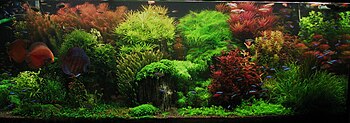
荷兰水族馆采用了一个郁郁葱葱的安排,其中具有不同叶子颜色,大小和纹理的多种类植物显示为花园中显示的陆地植物。这种风格自20世纪30年代开始在荷兰开发,因为淡水水族馆设备已经上市。[6]
日式风格
自然风格
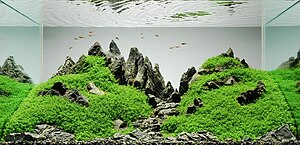
与荷兰风格对比的是自然水族馆或日本风格,由天野尚在20世纪90年代引入。 天野尚“自然水族馆世界”三系列引发了水族园艺的兴趣,被认为是在水族馆管理中树立新标准。[7]天野尚的作品采用日本园艺技术,试图通过相对较少植物种群的不对称布置来模拟自然景观,并设定了日本岩石花园规则|精心挑选的石头或漂流木,通常采用单一的焦点。目的是为了唤起一个微型的陆地景观,而不是一个五颜六色的花园。
这种风格特别吸引了日本的“侘寂”的审美观念,其重点是稍纵即逝和极简主义为美丽之源。颜色比荷兰风格更为有限,而景观并没有被完全覆盖。通常选择鱼类或淡水虾如多齿米虾和樱桃虾来补充植物和控制藻类,但由于极简主义的原因,物种数量往往受到限制。[8]
岩手风格
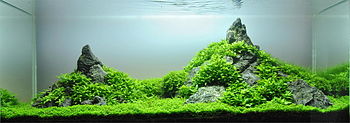
岩手风格是自然风格的具体亚型。 “岩组”的术语本身来自日本的岩层,是指石头扮演主角的布局。[9]
在岩手风格中,每块石头都有一个名字和一个具体的作用。岩石提供水景的骨骼结构,典型的几何体采用三个主要石头的设计,一个较大的石头和另外两个较小的石头,但也可以使用额外的岩石。[10]
亲石或主石被放置在水箱中略偏离中心,并将添石或伴随的石块分组在附近,而副石或二级石头则排列在下属位置。[11]
水族箱的焦点的位置主要由“大石”的不对称位置决定,被认为是重要的,并且遵循反映毕达哥拉斯调整的比率。[12]
丛林风格
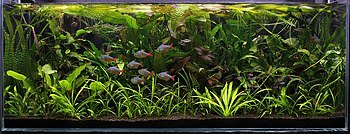
一些兴趣爱好者还指的是“丛林”(或“野生丛林”)风格,与荷兰或自然风格分开,并融入了其中的一些特征。植物被遗弃以自然,未修剪的外观。
丛林风格的水景通常具有很少或没有可见的硬景观材料,以及有限的开放空间。较粗的叶子形状,如棘鸟类动物,被用来提供野生,无名的外观。不像自然界,丛林风格不遵循 干净的线条或采用精细的纹理。可以使用较暗的底物,长大到表面的高植物和阻挡光线的浮动植物,提供昏暗的照明效果的组合来获得丛林冠层效应。
群落生境
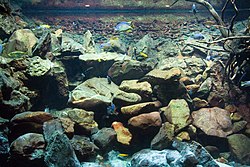
植物和鱼类根本不需要存在,但如果它们是,它们必须匹配在所代表的栖息地中的自然界中会发现的,以及任何砾石和硬质地,甚至水的化学成分。[15][16]
Paludariums

paludariums 是一个将水和土地结合在同一环境中的水族馆。 这些设计可以代表栖息地,包括热带雨林,丛林,溪流,沼泽,甚至海滩。[17] [18]
咸水礁
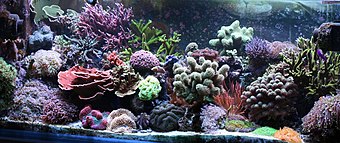
荷兰和自然风格的水景传统上是淡水系统。相比之下,咸水系统中可以种植相对较少的观赏植物。咸水造景通常以模仿珊瑚礁为中心。活岩的安排形成了这个水景的主要结构,它由珊瑚和其他海洋无脊椎动物以及珊瑚藻组成。[19][20]
照明在珊瑚礁水景中起著特别重要的作用。许多珊瑚含有共生荧光藻类的鞭毛藻,称为虫黄藻。[21]通过提供补充有紫外线波长的强光照,珊瑚礁鱼友不仅能够支持这些无脊椎动物的健康,而且还引起荧光微生物发出的特别鲜艳的色彩。[22]
技术

除了设计之外,淡水水族造景还需要具体的方法来保持水下的健康植物。植物经常被修剪以获得期望的形状,并且它们可以通过将它们绑在与丝线不明显的位置来定位。[24][25] 最重要的水族箱使用水族箱安全的肥料,通常是液体或片剂形式,以帮助植物更快地填充。[26] 一些含红土的水族底土也提供营养。[27]
还需要通过提供光和二氧化碳来支持光合作用。可以使用各种照明系统来产生完全可见的光谱。[28]灯通常由定时器控制,允许植物适应一定的周期。[28] 根据植物和鱼类的数量,水景也可能需要补充二氧化碳。这可以通过简单的自制系统完成,使用装有酵母、温水和糖的苏打水瓶,并连接到水族箱中的空气调节器,或者与加压的CO2罐注入将二氧化碳量放入水族箱水中。[29][30]

藻类(包括蓝细菌以及真正的藻类)通常不受青睐,认为是破坏景观,因此透过多种方式限制其生长,包括让虾或蜗牛等动物来吃掉藻类、控制光照、或以大量植物吸收水中的养份,使藻类缺乏养份。[31]
虽然专业的水族箱常使用大量的设备来提供照明、过滤和补充二氧化碳,但一些业余爱好者则选择使用最少的技术来维持植物生长。[32][33][34]
公共水族馆
大型公共水族馆有时候将水景作为展示的一部分。早在二十世纪二十年代,纽约水族馆则包括一个海鳗鳗鱼陈列柜,装饰有石灰石头岩石,安排类似珊瑚礁,并支持一些石珊瑚和海扇。[35] [36]
参考资料
- ^ Aquascaping 101 – An Introductory Guide for Beginners. FishTankSetups. 2017-06-16 [2017-06-21]. (原始内容存档于2017-09-25) (美国英语).
- ^ James, Barry, A Fishkeeper's Guide to Aquarium Plants, London: Tetra Press/Salamander Books, 1986, ISBN 0-86101-207-0
- ^ Mitchell, Sherry. The Fish Are Fine, but the Plants Are Fabulous. Washington Post. 2 October 2003 [27 July 2010]. (原始内容存档于2012-11-03).
- ^ Wei, Tan Karr. The exotic trade of aquascaping. Malaysia Star. 26 July 2007 [27 July 2010]. (原始内容存档于2012-10-14).
- ^ 5.0 5.1 Netburn, Deborah. Aquascaping: Aquarium meets terrarium in the Japanese-inspired design practice. Los Angeles Times. 19 September 2009 [27 July 2010]. (原始内容存档于2013-11-22).
- ^ Hudson, Robert Paul (30 May 2008), Going Dutch 互联网档案馆的存档,存档日期10 August 2009..
- ^ Axelrod, Herbert R., Warren E. Burgess, Neal Pronek, Glen S. Axelrod and David E. Boruchowitz (1998), Aquarium Fishes of the World, Neptune City, N.J.: T.F.H. Publications, p. 718, ISBN 0-7938-0493-0.
- ^ The Nature Aquarium Style (页面存档备份,存于互联网档案馆), 8 January 2014.
- ^ "Iwagumi and Sanzon Iwagumi Aquariums," Aquatic Eden website (页面存档备份,存于互联网档案馆), 11 February 2007.
- ^ The Iwagumi Layout: An Introduction (页面存档备份,存于互联网档案馆), 7 January 2014
- ^ Amano, Takashi (2009), How to improve your Iwagumi layout, The Aquatic Gardener, vol. 22, number 1, pp. 37–41.
- ^ "The Golden Rule of Aquascaping," Aquatic Eden website (页面存档备份,存于互联网档案馆), 16 November 2006.
- ^ Farmer, George. Our guide to aquascaping styles (PDF). UK Aquatic Plant Society. [28 September 2010]. (原始内容存档 (PDF)于15 August 2010).
- ^ Terver, Denis. Définition de aquascaping. Aquaportail. 2009 [28 September 2010]. (原始内容存档于22 September 2009) (法语).
- ^ James 1986,第37–45页.
- ^ "Biotope Aquaria," Mongabay.com (页面存档备份,存于互联网档案馆), 7 December 2004.
- ^ Paludariums: Discover Water Garden Terrariums!. [2017-09-11]. (原始内容存档于2017-09-12).
- ^ Paludariums.net (页面存档备份,存于互联网档案馆).
- ^ Borneman, Eric H., Aquarium Corals: Selection, Husbandry, and Natural History, Neptune City, N.J.: T.F.H. Publications: 323–341, 2004, ISBN 1-890087-47-5
- ^ Michael, Scott W. (November 2006), Aquascaping reef habitats, Aquarium Fish Magazine, pp. 66–73.
- ^ Borneman 2004,第47–55页.
- ^ Borneman 2004,第326–334页.
- ^ Alexander, Bob. The first Parlour Aquariums and the Victorian Aquarium Craze. History of parlour aquarium. parlouraquariums.org. November 2005 [24 December 2010]. (原始内容存档于22 July 2011).
- ^ Amano, Takashi (2008), Nature aquarium techniques to create & maintain an aquascape, The Aquatic Gardener, vol. 21, number 2, pp. 8–17.
- ^ Turon, Lluis Ruscalleda (2009), How to use Riccia and Java moss in the aquarium, The Aquatic Gardener, vol. 22, number 4, pp. 11–13.
- ^ James 1986,第16页.
- ^ James 1986,第28页.
- ^ 28.0 28.1 James 1986,第20–29页.
- ^ James 1986,第17页.
- ^ Nyberg, Tarah (2003), Yeast CO2 互联网档案馆的存档,存档日期18 July 2009., (Retrieved 10 October 2009).
- ^ James 1986,第46–47页.
- ^ Lass, David A. (March 2009), Three tough planted tanks, Aquarium Fish International, pp. 30–37.
- ^ Walstad, Diana (2003), Ecology of the planted aquarium: a practical manual and scientific treatise for the home aquarist, 2nd edition, Ashland Ohio: Atlas Books, ISBN 0-9673773-1-5.
- ^ Online forum on the "Natural" method. Aquaticplantcentral.com. [18 May 2012]. (原始内容存档于2017-09-22).
- ^ Townsend, Charles Haskins (1922, reprinted 2004), The Public Aquarium: Its Construction, Equipment, and Management, Honolulu: University Press of the Pacific, p. 17, ISBN 1-4102-1147-9.
- ^ Buckley, Kate (2010), Planted aquaria for zoological parks, The Aquatic Gardener, vol. 23, number 4, pp. 5–20.
进一步阅读
- Amano, Takashi (1992), Nature Aquarium World, Neptune City, N.J.: T.F.H. Publications, English translation by Christopher Perrius (in one volume), ISBN 0-7938-0089-7.
- Artists Create Mesmerizing Miniature Worlds, All Within The Confines Of A Fish Tank (页面存档备份,存于互联网档案馆), at the Huffington Post, February 4, 2014 (accessed February 17, 2014). Includes noteworthy photographs of aquascapes.
外部链接
The following sites offer tutorials, images, and in-depth discussions on aquascaping styles and techniques:
- Aquatic Gardeners Association (页面存档备份,存于互联网档案馆)
- UK Aquatic Plant Society (页面存档备份,存于互联网档案馆)
- Great Aquascapes Group at Flickr (页面存档备份,存于互联网档案馆)
- Aquatic Eden Website (页面存档备份,存于互联网档案馆)
- Advanced Aquascaping Guide (页面存档备份,存于互联网档案馆)
- Rotala Butterfly – Calculator tools for planted tanks (页面存档备份,存于互联网档案馆)
These sites provide extensive non-commercial descriptions of aquatic plant species and their use in aquascaping:
| ||||||||||||||||||||||||||||||||
Text is available under the CC BY-SA 4.0 license; additional terms may apply.
Images, videos and audio are available under their respective licenses.
